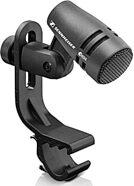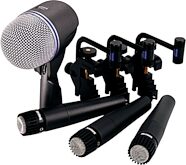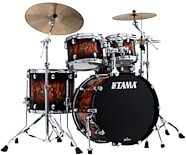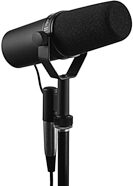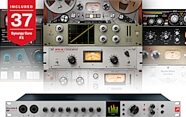Audio Technica ATM33a Artist Series Fixed-Charge Condenser Microphone
No longer available at zZounds
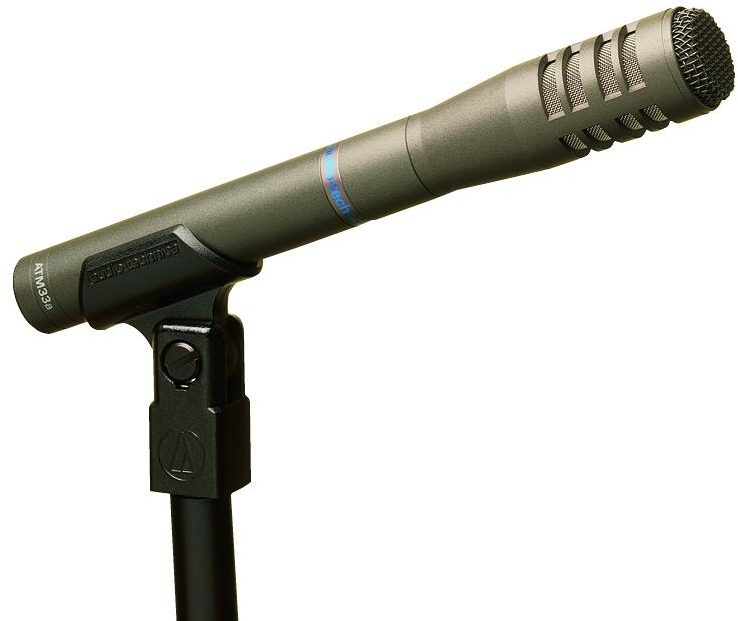
zZounds Gear Experts Say...
Cardioid condenser microphone. 9-52 volt remote power or 1.5 volt AA battery. S4 case style.
Overview
Features
Ideal for acoustic guitar, percussion, overheads, vocals, and more
Excels in both studio and stage applications
Outstanding linearity both on- and off-axis
Features high SPL capability and wide frequency response
Operates on battery or phantom power
A Word about Audio-Technica
Audio-Technica has been dedicated to advancing the art and technology of electro-acoustic design and manufacturing since 1962. From a beginning in state-of-the-art phono cartridges, A-T has expanded over the years into high-performance headphones, microphones, mixers, and electronic products for home and professional use. In each new area the goal has been to create innovative, problem-solving products. The results of these engineering and production efforts can be seen in the effective use of A-T products in a broad spectrum of applications.
Audio-Technica microphones, for example, are found in daily use in major broadcast and recording studios, and relied upon by top touring musicians. A-T mics are chosen for important installations and major events, such as the US House of Representatives, the US Senate, the Super Bowl, World Cup Soccer and the Olympics. Whether in the home, or in schools and universities, boardrooms, council chambers, or places of worship, Audio-Technica products are providing superior performance and exceptional value worldwide.
What a Microphone Does
Like phono cartridges, headphones, and loudspeakers, the microphone is a transducerÖin other words, an energy converter.… read more It senses acoustic energy (sound) and translates it into equivalent electrical energy. Amplified and sent to a loudspeaker or headphone, the sound picked up by the microphone transducer should emerge from the speaker transducer with no significant changes.
While there are many ways to convert sound into electrical energy, we'll concentrate on the 2 most popular methods: dynamic and condenser. These are the types of microphones most often found in recording studios, broadcast and motion picture production, home hi-fi and video recording, and on stages for live sound reinforcement.
About Dynamic Microphones
Comparison of microphone types to loudspeakers may help you more readily understand their operation. Dynamic microphones can be considered as similar to conventional loudspeakers in most respects. Both have a diaphragm (or cone) with a voice coil (a long coil of wire) attached near the apex. Both have a magnetic system with the coil in its gap. The difference is in how they are used. With a speaker, current from the amplifier flows through the coil. The magnetic field created by current flowing through the voice coil interacts with the magnetic field of the speaker's magnet, forcing the coil and its attached cone to move back and forth, producing sound output.
Dynamic Microphone Element
A dynamic microphone operates like a speaker "in reverse." Changing sound pressure moves the diaphragm. This moves the coil, which causes current to flow as lines of flux from the magnet are cut. So, instead of putting electrical energy into the coil (as in a speaker) you get energy out of it. In fact, many intercom systems use small speakers with lightweight cones as both speaker and microphone, by simply switching the same transducer from one end of the amplifier to the other. A speaker doesn't make a great microphone, but it's good enough for that application.
Dynamic microphones are renowned for their ruggedness and reliability. They need no batteries or external power supplies. They are capable of smooth, extended response, or are available with "tailored" response for special applications. Output level is high enough to work directly into most microphone inputs with an excellent signal-to-noise ratio. They need little or no regular maintenance, and with reasonable care will maintain their performance for many years.
About Condenser Microphones
Condenser (or capacitor) microphones use a lightweight membrane and a fixed plate that act as opposite sides of a capacitor. Sound pressure against this thin polymer film causes it to move. This movement changes the capacitance of the circuit, creating a changing electrical output. In many respects a condenser microphone functions in the same manner as an electrostatic tweeter, although on a much smaller scale and "in reverse."
Condenser microphones are preferred for their very uniform frequency response and ability to respond with clarity to transient sounds. The low mass of the membrane diaphragm permits extended high-frequency response, while the nature of the design also ensures outstanding low-frequency pickup. The resulting sound is natural, clean, and clear, with excellent transparency and detail.
Two basic types of condenser microphones are currently available. One uses an external power supply to provide the polarizing voltage needed for the capacitive circuit. These externally-polarized microphones are intended primarily for professional studio use or other extremely critical applications. A more recent development is the electret condenser microphone. In these models, the polarizing voltage is impressed on either the diaphragm or the back plate during manufacture, and this charge remains for the life of the microphone.
Electret Condenser Element
The best electret condenser microphones are capable of very high-quality performance, and are used extensively in broadcast, recording, and sound reinforcement. Due in part to their low-mass diaphragms, condenser microphones are inherently lower in handling or mechanical noise than dynamic microphones. For all of its electret condenser designs, Audio-Technica has elected to apply the polarizing voltage, or fixed-charge, to the back plate rather than the diaphragm. By doing this, a thinner material may be used for the diaphragm, providing a considerable performance advantage over electret microphones of conventional design. Many Audio-Technica microphone diaphragms, for example, are only 2 microns thick (less than 1/10,000th of an inch)!
Condenser elements have 2 other design advantages that make them the ideal (or the only) choice for many applications: they weigh much less than dynamic elements, and they can be much smaller. These characteristics make them the logical choice for line - or "shotgun" - microphones, lavaliers, and miniature microphones of all types. Attempts at miniaturizing dynamic microphones result in greatly reduced low-frequency response, overall loss in acoustic sensitivity, and higher mechanical or handling noise.
Phantom Power for Condenser Microphones
While the electret condenser microphone doesn't need a power supply to provide polarizing voltage, an FET impedance matching circuit inside the microphone does require some power. This may be supplied by a small low-voltage internal battery or by an external "phantom" supply.
Phantom powering is a technique that delivers a DC voltage to the microphone through the same shielded 2-conductor cable that carries the audio from the mic. The phantom power may be supplied either by the mic mixer or from an external supply that is "inserted" into the line between the microphone and mixer input. For phantom power to function, the line between the power supply and the microphone must be balanced to ground, and uninterrupted by such devices as filters or transformers that might pass the audio signal but block DC.
Phantom power also requires a continuous ground connection (Pin 1 in the XLR-type connector) from the power supply to the microphone. The supply delivers positive DC voltage equally to both signal-conducting leads, and uses the shield as a return path, or negative. Balanced-output dynamic microphones are not affected by the presence of phantom power, since there is no connection between the shield and either signal lead and, therefore, no circuit for the DC voltage.
Phantom power supplies are available in various output voltages ranging from as low as 9 volts up to 48 volts. They may be designed to operate from AC line voltages or from internal batteries. Externally polarized or "discrete" condenser microphones seldom have internal battery power. Instead, a phantom power source is used to provide both the polarizing voltage for the element and to power the impedance converter. This type is sometimes called a "pure condenser."
What's the Pattern
In addition to classifying microphones by their generating elements, they can also be identified by their directional properties, that is, how well they pick up sound from various directions. Most microphones can be placed in 1 of 2 main groups: omnidirectional and directional. Omnidirectional microphones are the simplest to design, build and understand. They also serve as a reference against which each of the others may be compared.
Omnidirectional
Omnidirectional microphones pick up sound from just about every direction equally. They'll work about as well pointed away from the subject as pointed toward it, if the distances are equal. However, even the best omni models tend to become directional at higher frequencies, so sound arriving from the back may seem a bit "duller" than sound from the front, although apparently equally "loud."
The physical size of the omnidirectional microphone has a direct bearing on how well the microphone maintains its omnidirectional characteristics at very high frequencies. The body of the microphone simply blocks the shorter high-frequency wavelengths that arrive from the rear. The smaller the microphone body diameter, therefore, the closer the microphone can come to being truly omnidirectional.
Directional
Directional microphones are specially designed to respond best to sound from the front (and rear in the case of bidirectionals), while tending to reject sound that arrives from other directions. This effect also varies with frequency, and only the better microphones are able to provide uniform rejection over a wide range of frequencies. This directional ability is usually the result of external openings and internal passages in the microphone that allow sound to reach both sides of the diaphragm in a carefully controlled way. Sound arriving from the front of the microphone will aid diaphragm motion, while sound arriving from the side or rear will cancel diaphragm motion.
The basic directional types include cardioid, subcardioid, hypercardioid, and bidirectional. Also included under the general heading of directional microphones is the line - or "shotgun" - a more complex design that can provide considerably higher directionality than the 4 basic directional types. read less
Ideal for acoustic guitar, percussion, overheads, vocals, and more
Excels in both studio and stage applications
Outstanding linearity both on- and off-axis
Features high SPL capability and wide frequency response
Operates on battery or phantom power
A Word about Audio-Technica
Audio-Technica has been dedicated to advancing the art and technology of electro-acoustic design and manufacturing since 1962. From a beginning in state-of-the-art phono cartridges, A-T has expanded over the years into high-performance headphones, microphones, mixers, and electronic products for home and professional use. In each new area the goal has been to create innovative, problem-solving products. The results of these engineering and production efforts can be seen in the effective use of A-T products in a broad spectrum of applications.
Audio-Technica microphones, for example, are found in daily use in major broadcast and recording studios, and relied upon by top touring musicians. A-T mics are chosen for important installations and major events, such as the US House of Representatives, the US Senate, the Super Bowl, World Cup Soccer and the Olympics. Whether in the home, or in schools and universities, boardrooms, council chambers, or places of worship, Audio-Technica products are providing superior performance and exceptional value worldwide.
What a Microphone Does
Like phono cartridges, headphones, and loudspeakers, the microphone is a transducerÖin other words, an energy converter.… read more It senses acoustic energy (sound) and translates it into equivalent electrical energy. Amplified and sent to a loudspeaker or headphone, the sound picked up by the microphone transducer should emerge from the speaker transducer with no significant changes.
While there are many ways to convert sound into electrical energy, we'll concentrate on the 2 most popular methods: dynamic and condenser. These are the types of microphones most often found in recording studios, broadcast and motion picture production, home hi-fi and video recording, and on stages for live sound reinforcement.
About Dynamic Microphones
Comparison of microphone types to loudspeakers may help you more readily understand their operation. Dynamic microphones can be considered as similar to conventional loudspeakers in most respects. Both have a diaphragm (or cone) with a voice coil (a long coil of wire) attached near the apex. Both have a magnetic system with the coil in its gap. The difference is in how they are used. With a speaker, current from the amplifier flows through the coil. The magnetic field created by current flowing through the voice coil interacts with the magnetic field of the speaker's magnet, forcing the coil and its attached cone to move back and forth, producing sound output.
Dynamic Microphone Element
A dynamic microphone operates like a speaker "in reverse." Changing sound pressure moves the diaphragm. This moves the coil, which causes current to flow as lines of flux from the magnet are cut. So, instead of putting electrical energy into the coil (as in a speaker) you get energy out of it. In fact, many intercom systems use small speakers with lightweight cones as both speaker and microphone, by simply switching the same transducer from one end of the amplifier to the other. A speaker doesn't make a great microphone, but it's good enough for that application.
Dynamic microphones are renowned for their ruggedness and reliability. They need no batteries or external power supplies. They are capable of smooth, extended response, or are available with "tailored" response for special applications. Output level is high enough to work directly into most microphone inputs with an excellent signal-to-noise ratio. They need little or no regular maintenance, and with reasonable care will maintain their performance for many years.
About Condenser Microphones
Condenser (or capacitor) microphones use a lightweight membrane and a fixed plate that act as opposite sides of a capacitor. Sound pressure against this thin polymer film causes it to move. This movement changes the capacitance of the circuit, creating a changing electrical output. In many respects a condenser microphone functions in the same manner as an electrostatic tweeter, although on a much smaller scale and "in reverse."
Condenser microphones are preferred for their very uniform frequency response and ability to respond with clarity to transient sounds. The low mass of the membrane diaphragm permits extended high-frequency response, while the nature of the design also ensures outstanding low-frequency pickup. The resulting sound is natural, clean, and clear, with excellent transparency and detail.
Two basic types of condenser microphones are currently available. One uses an external power supply to provide the polarizing voltage needed for the capacitive circuit. These externally-polarized microphones are intended primarily for professional studio use or other extremely critical applications. A more recent development is the electret condenser microphone. In these models, the polarizing voltage is impressed on either the diaphragm or the back plate during manufacture, and this charge remains for the life of the microphone.
Electret Condenser Element
The best electret condenser microphones are capable of very high-quality performance, and are used extensively in broadcast, recording, and sound reinforcement. Due in part to their low-mass diaphragms, condenser microphones are inherently lower in handling or mechanical noise than dynamic microphones. For all of its electret condenser designs, Audio-Technica has elected to apply the polarizing voltage, or fixed-charge, to the back plate rather than the diaphragm. By doing this, a thinner material may be used for the diaphragm, providing a considerable performance advantage over electret microphones of conventional design. Many Audio-Technica microphone diaphragms, for example, are only 2 microns thick (less than 1/10,000th of an inch)!
Condenser elements have 2 other design advantages that make them the ideal (or the only) choice for many applications: they weigh much less than dynamic elements, and they can be much smaller. These characteristics make them the logical choice for line - or "shotgun" - microphones, lavaliers, and miniature microphones of all types. Attempts at miniaturizing dynamic microphones result in greatly reduced low-frequency response, overall loss in acoustic sensitivity, and higher mechanical or handling noise.
Phantom Power for Condenser Microphones
While the electret condenser microphone doesn't need a power supply to provide polarizing voltage, an FET impedance matching circuit inside the microphone does require some power. This may be supplied by a small low-voltage internal battery or by an external "phantom" supply.
Phantom powering is a technique that delivers a DC voltage to the microphone through the same shielded 2-conductor cable that carries the audio from the mic. The phantom power may be supplied either by the mic mixer or from an external supply that is "inserted" into the line between the microphone and mixer input. For phantom power to function, the line between the power supply and the microphone must be balanced to ground, and uninterrupted by such devices as filters or transformers that might pass the audio signal but block DC.
Phantom power also requires a continuous ground connection (Pin 1 in the XLR-type connector) from the power supply to the microphone. The supply delivers positive DC voltage equally to both signal-conducting leads, and uses the shield as a return path, or negative. Balanced-output dynamic microphones are not affected by the presence of phantom power, since there is no connection between the shield and either signal lead and, therefore, no circuit for the DC voltage.
Phantom power supplies are available in various output voltages ranging from as low as 9 volts up to 48 volts. They may be designed to operate from AC line voltages or from internal batteries. Externally polarized or "discrete" condenser microphones seldom have internal battery power. Instead, a phantom power source is used to provide both the polarizing voltage for the element and to power the impedance converter. This type is sometimes called a "pure condenser."
What's the Pattern
In addition to classifying microphones by their generating elements, they can also be identified by their directional properties, that is, how well they pick up sound from various directions. Most microphones can be placed in 1 of 2 main groups: omnidirectional and directional. Omnidirectional microphones are the simplest to design, build and understand. They also serve as a reference against which each of the others may be compared.
Omnidirectional
Omnidirectional microphones pick up sound from just about every direction equally. They'll work about as well pointed away from the subject as pointed toward it, if the distances are equal. However, even the best omni models tend to become directional at higher frequencies, so sound arriving from the back may seem a bit "duller" than sound from the front, although apparently equally "loud."
The physical size of the omnidirectional microphone has a direct bearing on how well the microphone maintains its omnidirectional characteristics at very high frequencies. The body of the microphone simply blocks the shorter high-frequency wavelengths that arrive from the rear. The smaller the microphone body diameter, therefore, the closer the microphone can come to being truly omnidirectional.
Directional
Directional microphones are specially designed to respond best to sound from the front (and rear in the case of bidirectionals), while tending to reject sound that arrives from other directions. This effect also varies with frequency, and only the better microphones are able to provide uniform rejection over a wide range of frequencies. This directional ability is usually the result of external openings and internal passages in the microphone that allow sound to reach both sides of the diaphragm in a carefully controlled way. Sound arriving from the front of the microphone will aid diaphragm motion, while sound arriving from the side or rear will cancel diaphragm motion.
The basic directional types include cardioid, subcardioid, hypercardioid, and bidirectional. Also included under the general heading of directional microphones is the line - or "shotgun" - a more complex design that can provide considerably higher directionality than the 4 basic directional types. read less
Specs
Element: Condenser
Dynamic Range (Typical):
PHANTOM 113 dB, 1 kHz at Max. SPL
BATTERY 99 dB, 1 kHz at Max. SPL
Polar Pattern: Cardioid
Phantom Power Requirements: 9 - 52V, 2 mA typical
Frequency Response: 30 - 20,000 Hz
Battery Type: 1.5V AA/UM3
Open Circuit Sensitivity:
PHANTOM -44 dB (6.3 mV) re 1V at 1 Pa
BATTERY -45 dB (5.6 mV) re 1V at 1 Pa
Battery Current/Life: 0.4 mA/1200 hours typical
Impedance:
PHANTOM 200 ohms
BATTERY 270 ohms
Weight: 5.3 oz (150 g)
Maximum Input Sound Level:
PHANTOM 137 dB SPL, 1 kHz at 1% T.H.D.
BATTERY 123 dB SPL, 1 kHz at 1% T.H.D.
Output Connector: XLRM-type
Signal to Noise Ratio: 70 dB, 1 kHz at 1 Pa
Accessories furnished: AT8405 stand clamp; AT8136 foam windscreen; battery; protective pouch
Dynamic Range (Typical):
PHANTOM 113 dB, 1 kHz at Max. SPL
BATTERY 99 dB, 1 kHz at Max. SPL
Polar Pattern: Cardioid
Phantom Power Requirements: 9 - 52V, 2 mA typical
Frequency Response: 30 - 20,000 Hz
Battery Type: 1.5V AA/UM3
Open Circuit Sensitivity:
PHANTOM -44 dB (6.3 mV) re 1V at 1 Pa
BATTERY -45 dB (5.6 mV) re 1V at 1 Pa
Battery Current/Life: 0.4 mA/1200 hours typical
Impedance:
PHANTOM 200 ohms
BATTERY 270 ohms
Weight: 5.3 oz (150 g)
Maximum Input Sound Level:
PHANTOM 137 dB SPL, 1 kHz at 1% T.H.D.
BATTERY 123 dB SPL, 1 kHz at 1% T.H.D.
Output Connector: XLRM-type
Signal to Noise Ratio: 70 dB, 1 kHz at 1 Pa
Accessories furnished: AT8405 stand clamp; AT8136 foam windscreen; battery; protective pouch
Documents and Manuals
For support or warranty questions, please contact the manufacturer:
Phone: 330-686-2600 x5000
Email: audio-solutions@atus.com
Phone: 330-686-2600 x5000
Email: audio-solutions@atus.com
Reviews
Reviewers gave this product an overall rating of 3 out of 5 stars.
(22 ratings)
Submitted April 14, 2006 by Geoff Taylor
"Slightly disappointing......"
I got a pair of these to back up/replace a couple of ATM 11s I've been using for years to record choirs and orchestras on location. Unlike the ATM 11s, these can run on phantom power as well as batteries, so I expected them to sound similar but a bit better, with more headroom, etc. It may be me, but I don't think they sound as good, to be honest. They seem to produce a less 'open' sound, and do not particularly like loud percussive sounds.
Build quality is fine, and I'd expect them to last as long as other AT stuff I've used. Do mics get better with age...........?
8 of 14 people (57%) people found this review helpful. Did you?
Thanks for your opinion!
No longer available at zZounds
In most cases, a product is unavailable because it has been discontinued by the manufacturer
This is a carousel with product cards. Use the previous and next buttons to navigate.




